Decoupling Uplink and Downlink Access for NGEO Satellite Communications with In-Line Interference Avoidance
Abstract
:1. Introduction
2. System Model
2.1. Multi-Layer Satellite System
2.2. Geometry Model Based on Geocentric Angle
2.3. Propagation Model
3. The Proposed Decoupling Uplink and Downlink Access Scheme
3.1. Signal Interference Noise Ratio
3.2. DUDA Protocol for Centralized Network Systems
- Case 1: Both access in UL and DL:
- Case 2: Both access in UL and DL
- Case 3: Access in UL while access in DL
- Case 4: Access in UL while access in DL
3.3. Performance Analysis
4. DUDA Scheme for Interference Avoidance
4.1. Interference Avoidance Criteria
4.2. Satellite Association
5. Simulation Results
5.1. Parameters Setting
5.2. Baseline
5.3. Probability Results
5.4. Comparison of the Throughout Capacity
6. Conclusions
Author Contributions
Funding
Data Availability Statement
Conflicts of Interest
References
- You, X.; Wang, C.X.; Huang, J.; Gao, X.; Zhang, Z.; Wang, M.; Huang, Y.; Zhang, C.; Jiang, Y.; Wang, J.; et al. Towards 6G wireless communication systems: Vision, enabling technologies, and new paradigm shifts. Sci. China Inf. Sci. 2021, 64, 110301. [Google Scholar] [CrossRef]
- Centenaro, M.; Costa, C.E.; Granelli, F.; Sacchi, C.; Vangelista, L. A Survey on Technologies, Standards and Open Challenges in Satellite IoT. IEEE Commun. Surv. Tutorials 2021, 23, 1693–1720. [Google Scholar] [CrossRef]
- Wei, T.; Feng, W.; Chen, Y.; Wang, C.X.; Ge, N.; Lu, J. Hybrid Satellite-Terrestrial Communication Networks for the Maritime Internet of Things: Key Technologies, Opportunities, and Challenges. IEEE Internet Things J. 2021, 8, 8910–8934. [Google Scholar] [CrossRef]
- Ahmed, A.; Al-Dweik, A.; Iraqi, Y.; Damiani, E. Integrated Terrestrial-Wired and LEO Satellite With Offline Bidirectional Cooperation for 6G IoT Networks. IEEE Internet Things J. 2024, 11, 15767–15782. [Google Scholar] [CrossRef]
- Zhang, Y.; Ni, W.; Mao, Y.; Ning, B.; Xiao, S.; Tang, W.; Niyato, D. Rate-Splitting Multiple Access for Covert Communications. IEEE Wirel. Commun. Lett. 2024, 13, 1685–1689. [Google Scholar] [CrossRef]
- Bing, L.; Gu, Y.; Hu, L.; Aulin, T.; Yin, Y.; Wang, J. QoS Provision for Industrial IoT Networking: Multiantenna NOMA Based on Partial CSIT. IEEE Trans. Ind. Inform. 2024, 20, 8239–8250. [Google Scholar] [CrossRef]
- Elshaer, H.; Boccardi, F.; Dohler, M.; Irmer, R. Downlink and Uplink Decoupling: A disruptive architectural design for 5G systems. In Proceedings of the 2014 IEEE Global Communications Conference, Austin, TX, USA, 8–12 December 2014; pp. 1798–1803. [Google Scholar]
- Boccardi, F.; Andrews, J.; Elshaer, H.; Dohler, M.; Parkvall, S.; Popovski, P.; Singh, S. Why to decouple the uplink and downlink in cellular systems and how to do it. IEEE Commun. Mag. 2016, 54, 110–117. [Google Scholar] [CrossRef]
- Smiljkovikj, K.; Popovski, P.; Gavrilovska, L. Analysis of the Decoupled Access for Downlink and Uplink in Wireless Heterogeneous Networks. IEEE Wirel. Commun. Lett. 2015, 4, 173–176. [Google Scholar] [CrossRef]
- Bacha, M.; Wu, Y.; Clerckx, B. Downlink and Uplink Decoupling in Two-Tier Heterogeneous Networks With Multi- Antenna Base Stations. IEEE Trans. Wirel. Commun. 2017, 16, 2760–2775. [Google Scholar] [CrossRef]
- Zhang, L.; Nie, W.; Feng, G.; Zheng, F.C.; Qin, S. Uplink Performance Improvement by Decoupling Uplink/Downlink Access in HetNets. IEEE Trans. Veh. Technol. 2017, 66, 6862–6876. [Google Scholar] [CrossRef]
- Arif, M.; Wyne, S.; Navaie, K.; Nawaz, S.J.; Alvi, S.H. Decoupled Downlink and Uplink Access for Aerial Terrestrial Heterogeneous Cellular Networks. IEEE Access 2020, 8, 111172–111185. [Google Scholar] [CrossRef]
- Shi, Y.; Alsusa, E.; Baidas, M.W. Downlink-Uplink Decoupled Access in Heterogeneous Cellular Networks with UAVs. In Proceedings of the 2020 IEEE 31st Annual International Symposium on Personal, Indoor and Mobile Radio Communications, London, UK, 31 August–3 September 2020; pp. 1–6. [Google Scholar]
- Veeravalli, V.; El Gamal, A. Interference Management in Wireless Networks: Fundamental Bounds and the Role of Cooperation; Cambridge University Press: Cambridge, UK, 2018. [Google Scholar]
- Sharma, S.K.; Chatzinotas, S.; Ottersten, B. In-line interference mitigation techniques for spectral coexistence of GEO and NGEO satellites. Int. J. Satell. Commun. Netw. 2016, 34, 11–39. [Google Scholar] [CrossRef]
- Pourmoghadas, A.; Sharma, S.K.; Chatzinotas, S.; Ottersten, B. On the apectral coexistence of GSO and NGSO FSS systems: Power control mechanisms and a methodology for inter-site distance determination. Int. J. Satell. Commun. Netw. 2016, 35, 443–459. [Google Scholar] [CrossRef]
- Zhang, C.; Jiang, C.; Kuang, L.; Jin, J.; He, Y.; Han, Z. Spatial Spectrum Sharing for Satellite and Terrestrial Communication Networks. IEEE Trans. Aerosp. Electron. Syst. 2019, 55, 1075–1089. [Google Scholar] [CrossRef]
- Wang, H.; Wang, C.; Yuan, J.; Zhao, Y.; Ding, R.; Wang, W. Coexistence Downlink Interference Analysis Between LEO System and GEO System in Ka Band. In Proceedings of the 2018 IEEE/CIC International Conference on Communications in China (ICCC), Beijing, China, 16–18 August 2018; pp. 465–469. [Google Scholar]
- Wang, R.; Kishk, M.A.; Alouini, M.S. Evaluating the Accuracy of Stochastic Geometry Based Models for LEO Satellite Networks Analysis. IEEE Commun. Lett. 2022, 26, 2440–2444. [Google Scholar] [CrossRef]
- Al-Hourani, A. An Analytic Approach for Modeling the Coverage Performance of Dense Satellite Networks. IEEE Wirel. Commun. Lett. 2021, 10, 897–901. [Google Scholar] [CrossRef]
- ITU-R S.672-4. Satellite Antenna Radiation Pattern for Use as a Design Objective in the Fixed-Satellite Service Employing Geostationary Satellites. January 2010. Available online: https://www.itu.int/rec/R-REC-S.672/en (accessed on 12 August 2024).
- ITU-R S.1528. Satellite Antenna Radiation Patterns for Nongeostationary Orbit Satellite Antennas Operating in the Fixed Satellite Service Below 30 GHz. 2001. Available online: https://www.itu.int/rec/R-REC-S.1528/en (accessed on 12 August 2024).
- ITU-R S.465-6. Reference Radiation Pattern for Earth Station Antennas in the Fixed-Satellite Service for Use in Coordination and Interference Assessment in the Frequency Range from 2 to 31 GHz. January 2010. Available online: https://www.itu.int/rec/R-REC-S.465/en (accessed on 12 August 2024).
- ITU-R S.1428. Reference FSS Earth Station Radiation Patterns for Use in Interference Assessment Involving Non-GSO Satellite in Frequency Bands between 10.7 GHz and 30 GHz. 2000. Available online: https://www.itu.int/dms_pubrec/itu-r/rec/s/R-REC-S.1428-1-200102-I!!PDF-E.pdf (accessed on 12 August 2024).
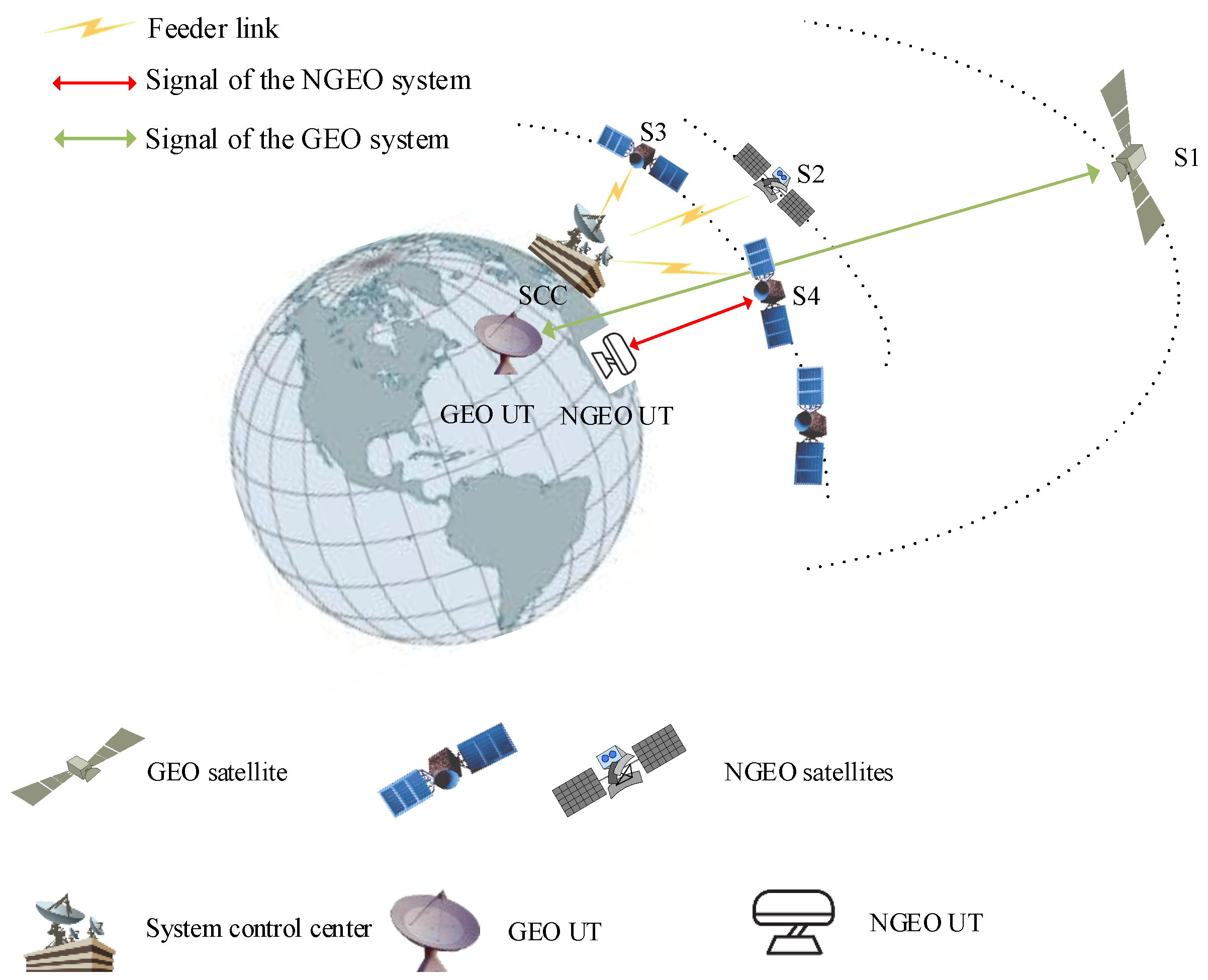

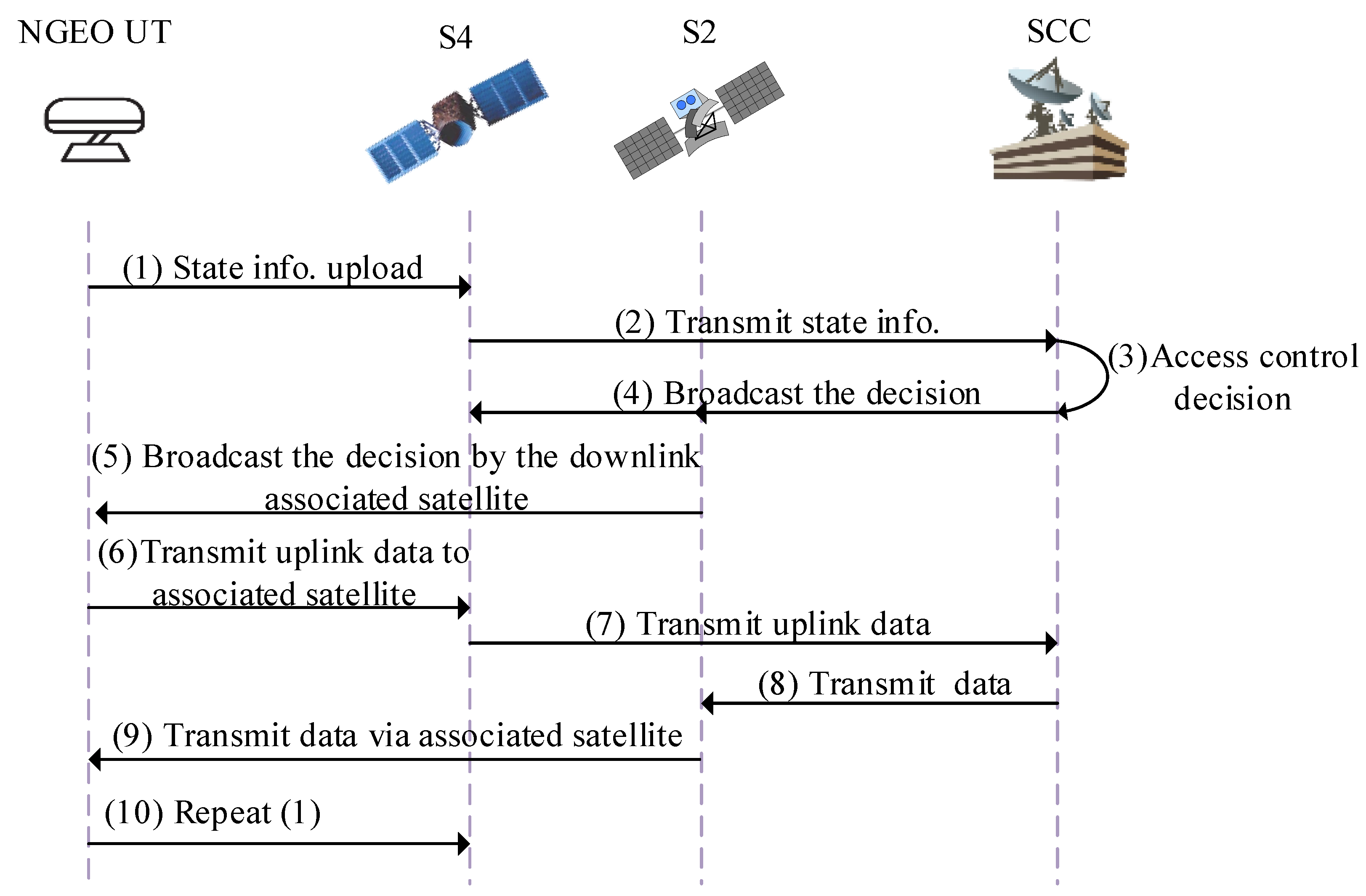
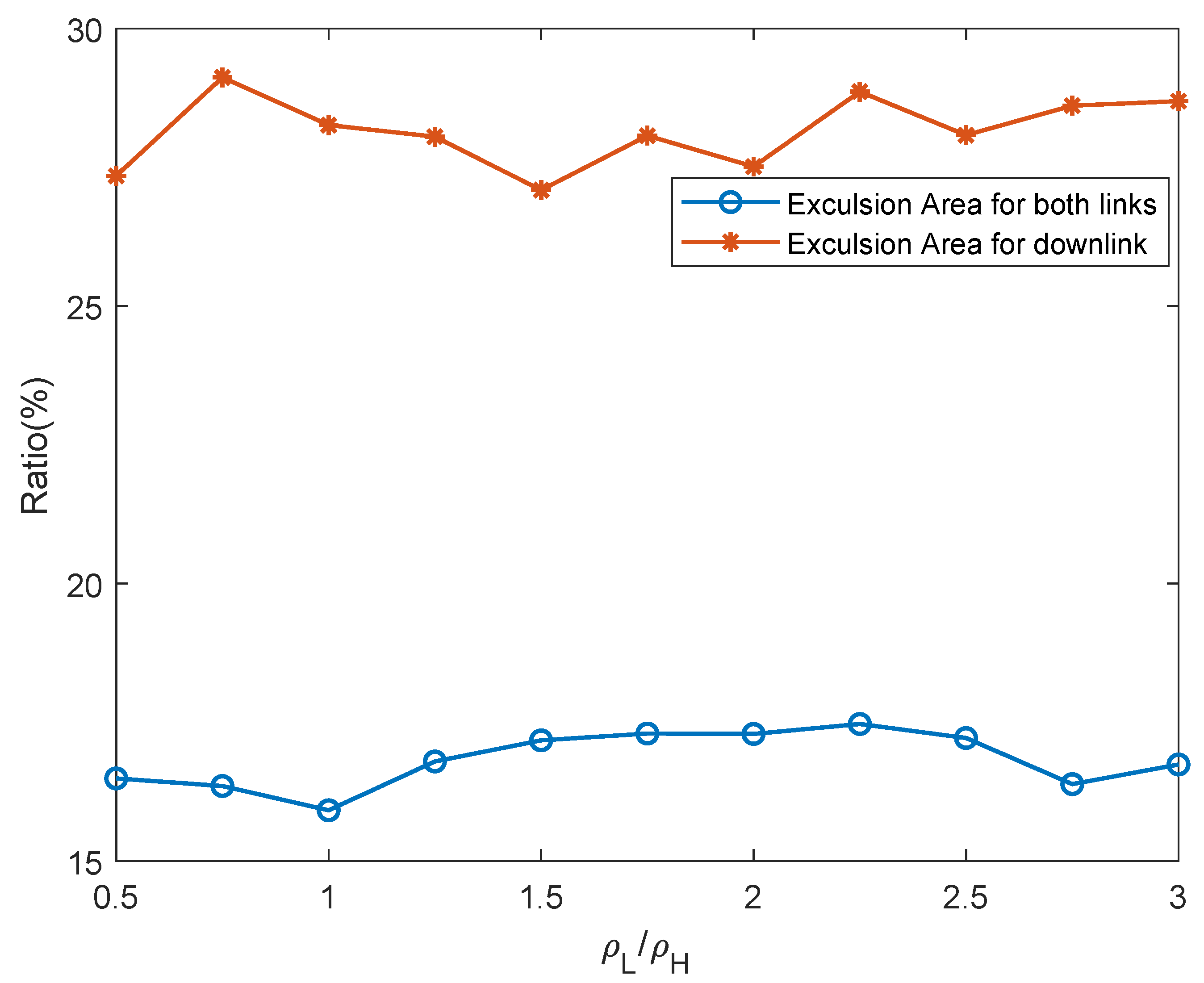
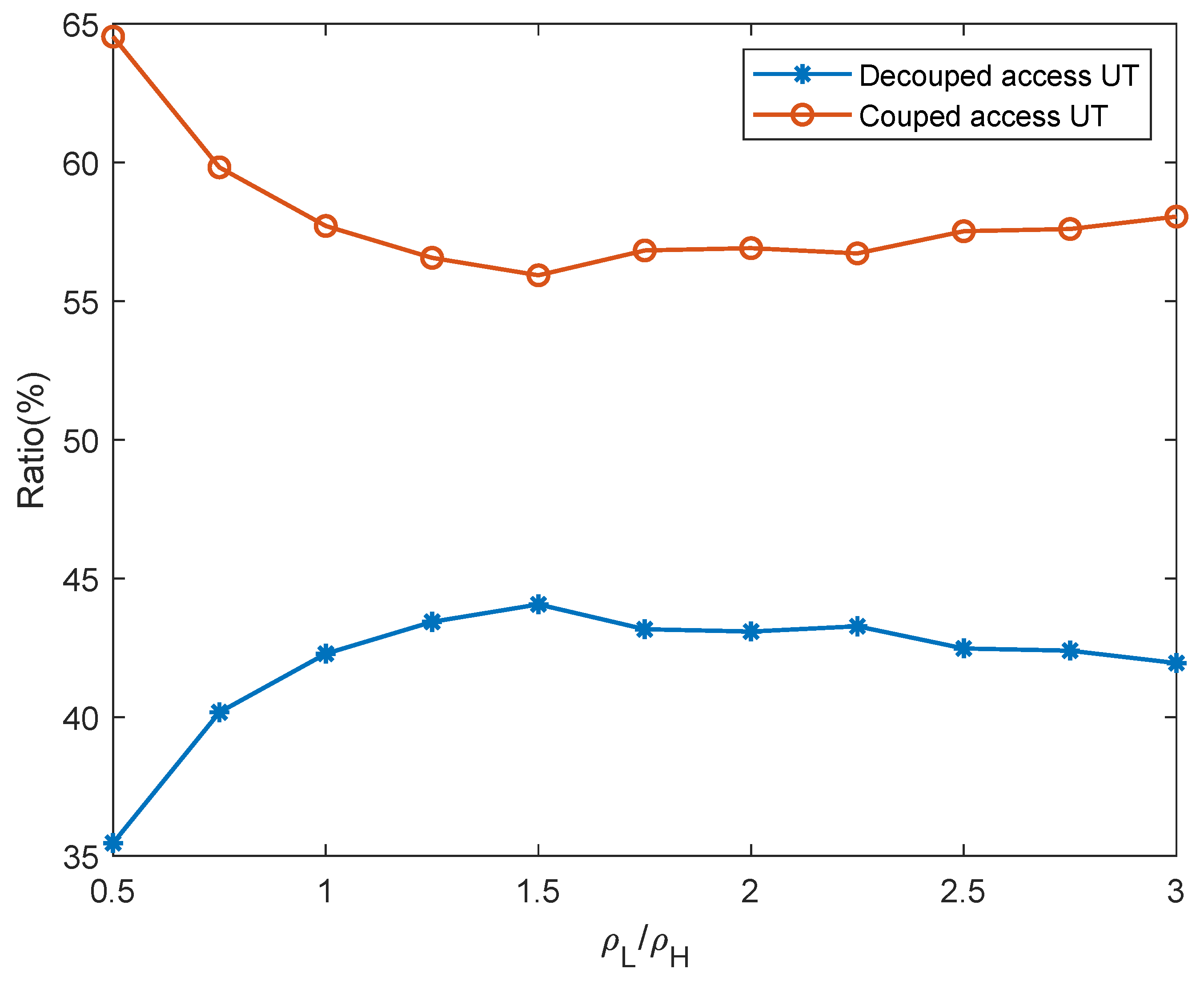
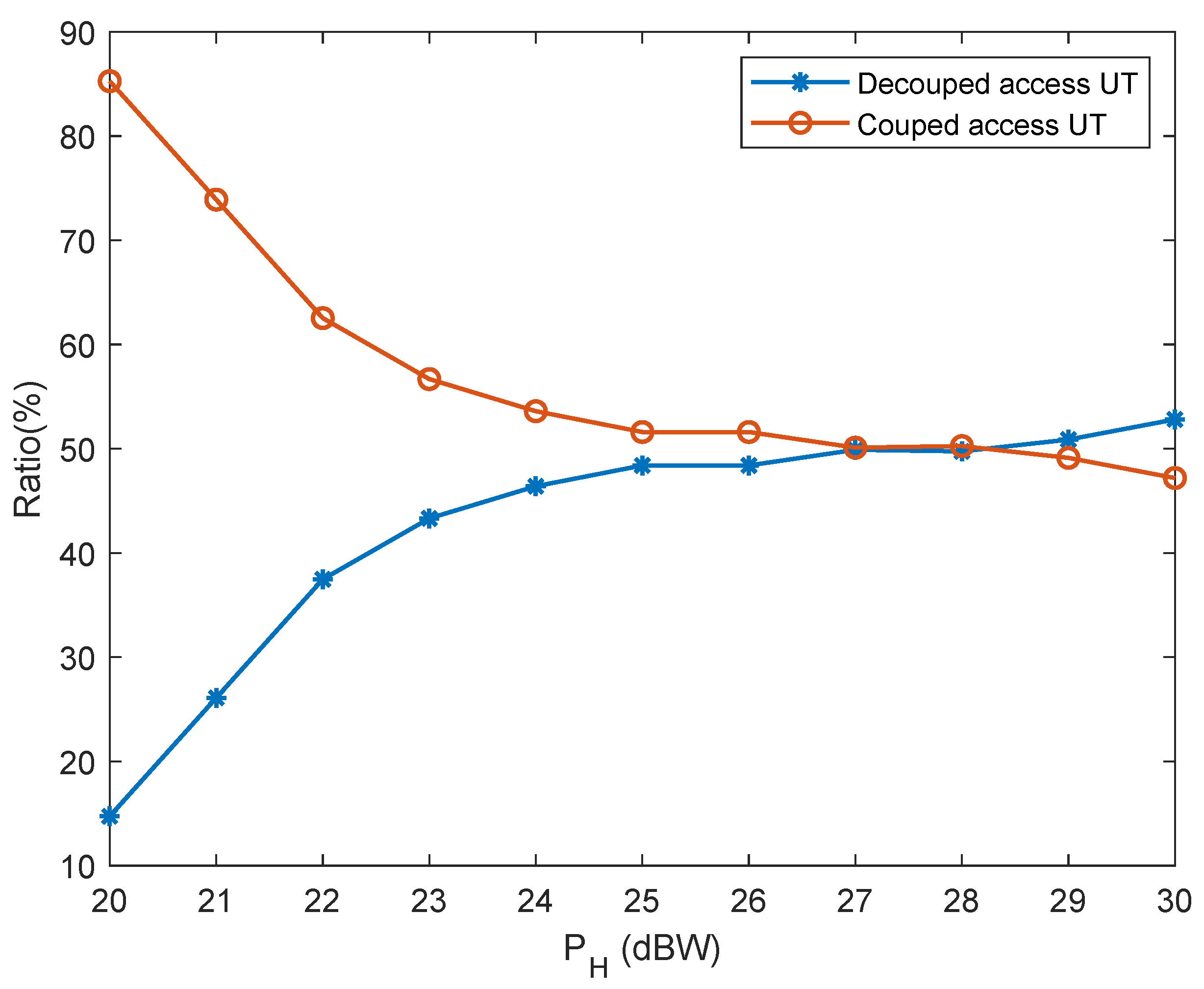
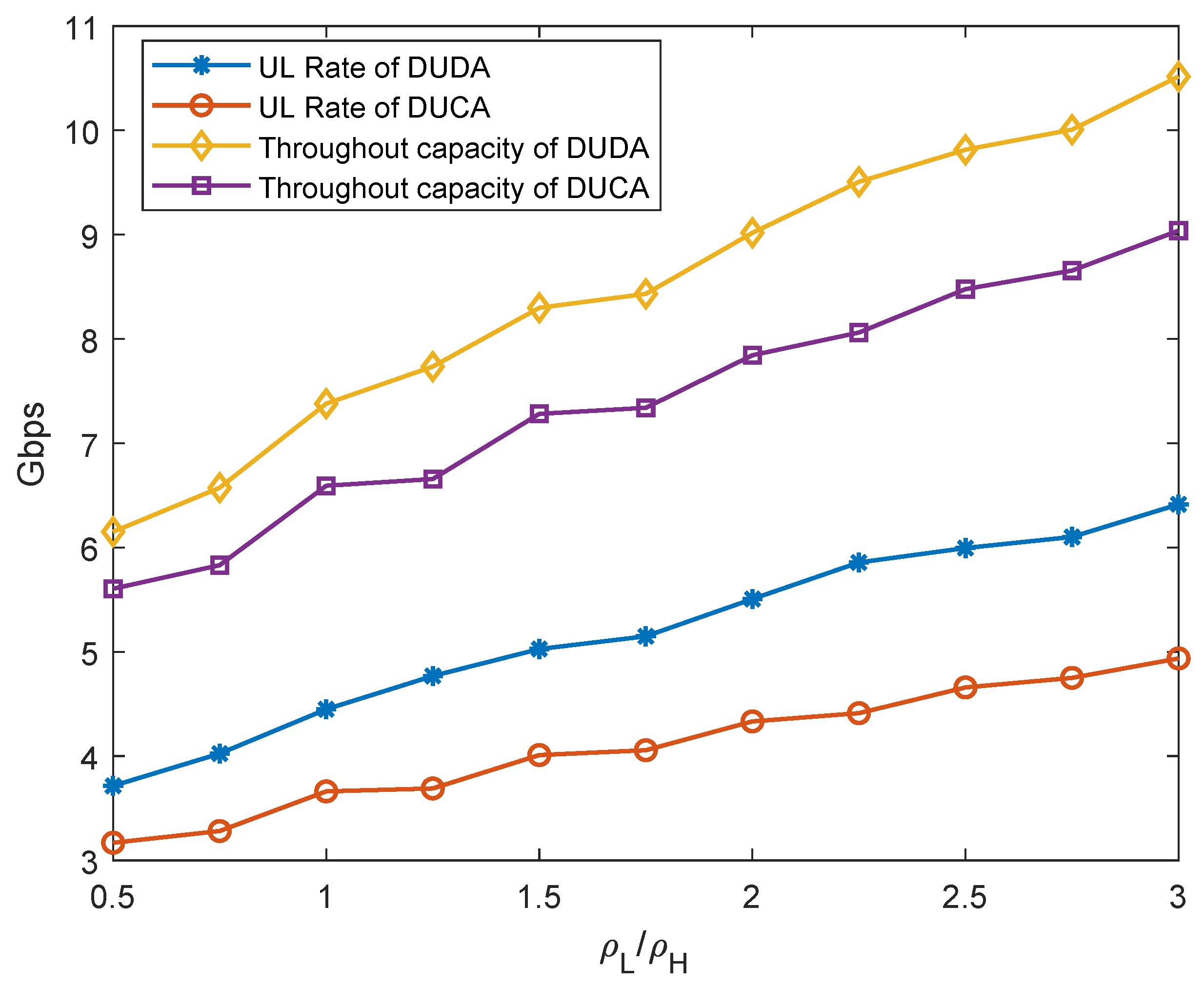

| Items | Values |
|---|---|
| Carrier frequency for uplink | 30 GHz |
| Carrier frequency for downlink | 20 GHz |
| Signal bandwidth | 10 MHz |
| Maximum antenna gain of the GEO satellite | 47 dBi |
| Maximum antenna gain of the GEO UT | 41 dBi |
| Maximum antenna gain of NGEO satellites | 41 dBi |
| The mean number of the NGEO satellites () | 40 (H-th tier) |
| EIRP of the NGEO UTs | 54 dBW |
| Maximum antenna gain of the NGEO UTs | 37 dBi |
| The mean number of NGEO UTs () | 100 |
| Exclusion angle for uplink () | |
| Exclusion angle for downlink () |
Disclaimer/Publisher’s Note: The statements, opinions and data contained in all publications are solely those of the individual author(s) and contributor(s) and not of MDPI and/or the editor(s). MDPI and/or the editor(s) disclaim responsibility for any injury to people or property resulting from any ideas, methods, instructions or products referred to in the content. |
© 2024 by the authors. Licensee MDPI, Basel, Switzerland. This article is an open access article distributed under the terms and conditions of the Creative Commons Attribution (CC BY) license (https://creativecommons.org/licenses/by/4.0/).
Share and Cite
Liu, Y.; Liu, Y.; Kuai, X. Decoupling Uplink and Downlink Access for NGEO Satellite Communications with In-Line Interference Avoidance. Electronics 2024, 13, 3245. https://doi.org/10.3390/electronics13163245
Liu Y, Liu Y, Kuai X. Decoupling Uplink and Downlink Access for NGEO Satellite Communications with In-Line Interference Avoidance. Electronics. 2024; 13(16):3245. https://doi.org/10.3390/electronics13163245
Chicago/Turabian StyleLiu, Yilun, Yujie Liu, and Xiaoyan Kuai. 2024. "Decoupling Uplink and Downlink Access for NGEO Satellite Communications with In-Line Interference Avoidance" Electronics 13, no. 16: 3245. https://doi.org/10.3390/electronics13163245






